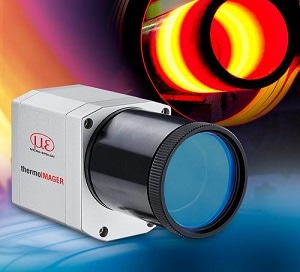Micro-Epsilon’s thermoIMAGER TIM M1 thermal imager for temperature measurement of metals is now available with an integrated notch filter, which prevents damage to the detector when the camera is exposed to lasers used in welding processes.

This means the thermal imager can now be used in a range of laser processing applications such as laser welding, laser additive machining and brazing.
Due to its short-wave spectral range of 1µm, the TIM M1 is ideal for temperature measurement applications in metal processing, including the temperature monitoring of metal hardening and forming processes. In the range 0.92µm to 1.1µm, metals are subject to a significantly higher emissivity than in other wavelength ranges.
Lasers used in welding and laser machining also have a wavelength in the centre of the TIM M1’s wavelength range and, if left unfiltered, would cause damage to the thermal imager’s CMOS detector. The integrated notch filter on the TIM M1 blocks these lasers at 1064nm, preventing the detector from being destroyed.
In addition to the integrated notch filter, the TIM M1 has another new feature, a high speed (1kHz) linescanning mode, which allows the detection of extremely small material defects, including cracks on fast-moving metal objects such as steel bars, slabs, pipes and rails. The scanning line can be freely positioned inside the image array.
The TIM M1 is a compact, robust (IP67) short wavelength infrared thermal imaging camera, which is specifically designed to measure the surface temperature of hot metals, as well as ceramics and graphite.
The camera offers a significant cost advantage, with a selling price that is similar to currently available short wavelength spot pyrometers.
The thermoIMAGER TIM M1 has a high resolution CMOS detector with 764 x 480 pixels, a temperature measuring range of 450°C to 1800°C. It is very compact at just 46 x 56 x 90mm, yet for harsh environments, can be supplied with a large stainless steel air or water-cooled housing that can operate in 315°C ambient temperatures.
The M1 is supplied with the licence-free TIMConnect operating and analysis software as standard, which includes a variety of process control features, including an ‘image merging’ function.
This smart feature allows the user to view multiple cameras on a single screen and process these as ‘one image’. This is a very useful tool when users need to monitor a large target or area, for example, when searching for hotspots in a long production line.
The M1 can be set up to provide detailed analysis of high speed, thermodynamic processes and is able to output analogue temperature or alert values via the process interface (PIF).
Powered and operated via a USB 2.0 interface, the M1 provides temperature images and profiles of a target area. This plug-and-play unit enables the real time capture and storage of images or video of an event for slow motion play back or snapshots at a later date – a key feature for Quality, R&D and inspection work.
The M1 operates in ambient temperatures of 0°C to +50°C (+315°C with an integrated cooling jacket). High temperature (HT) versions of the cables are also available for use with cooling jackets. The TIM USB Gigabit Server enables extended cable lengths of up to 100m via Ethernet.
For more information, please call the Micro-Epsilon sales department on 0151 355 6070 or email [email protected]